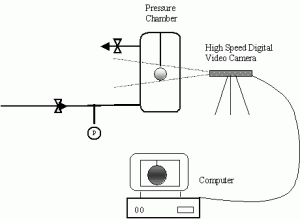The demand for high-performance and improved safety propellants for various rocket motor applications has been constantly increasing during the last decades and gels seem to be a promising answer to these requirements. In this particular solid-liquid state, these propellants combine the advantages of the solids with those of liquids.
Gels are liquids whose rheological properties have been altered by the addition of certain gelling agents (gellants) and as a result their behavior resembles that of solids. According to Brinker and Scherer, a gel is defined as a substance that contains a continuous solid skeleton enclosing a continuous liquid phase. The continuity of the solid structure gives elasticity to the gel.
The status of gel propellants in year 2000.
Gel Droplet Combustion
Current status can be found in:
- Experimental Investigation of the Combustion of Organic-Gellant-Based Gel Fuel Droplets.
The demand for high-performance and improved safety propellants for various rocket motor applications has been constantly increasing during the last decades and gels seem to be a promising answer to these requirements. In this particular solid-liquid state, these propellants combine the advantages of the solids with those of liquids. Gels are liquids whose rheological properties have been altered by the addition of certain gelling agents (gellants) and as a result their behavior resembles that of solids. According to Brinker and Scherer, a gel is defined as a substance that contains a continuous solid skeleton enclosing a continuous liquid phase. The continuity of the solid structure gives elasticity to the gel.
In a basic experimental study, Nachmoni and Natan indicated that in general, gels obey the d2-law of diffusion-controlled combustion. The heat of vaporization of gels was found to increase with increasing gellant content in the liquid fuel and gels burned at lower burning rates than the pure liquid.
The purpose of experimental studies conducted in the lab is to characterize qualitatively the combustion behavior of gel fuel droplets.
A schematic diagram of the experimental system is presented below. The experimental apparatus enables a wide scope of single droplet combustion experiments using a variety of liquid and gel fuels, different ambient gaseous compositions and pressure levels higher than 100 bars. Within a pressure chamber, the droplet is suspended on a thin Pyrex wire by its surface tension or colloid forces. The droplet is ignited and the combustion process was video-photographed by a high-speed (up to 2,000 frames/sec) digital video camera (Redlake Imaging MotionScope e/Cam 2000 SC color digital camera with magnifying lenses) through an optical glass window located at the side of the pressure chamber. The high speed allowed observation of very fast phenomena such as micro-explosions or droplet collapse.
Additional information can be found in: Experimental Investigation of the Combustion (PDF File)

Gel Propellants Atomization
Current status can be found in:

